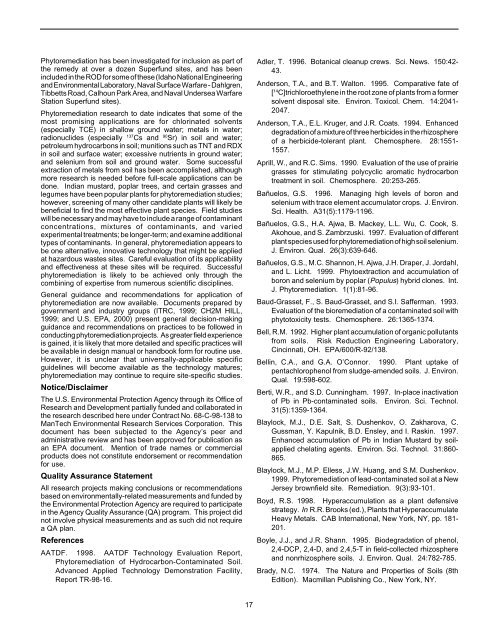Ground Water Issue Phytoremediation of Contaminated ... - CLU-IN
Ground Water Issue Phytoremediation of Contaminated ... - CLU-IN
Ground Water Issue Phytoremediation of Contaminated ... - CLU-IN
Create successful ePaper yourself
Turn your PDF publications into a flip-book with our unique Google optimized e-Paper software.
<strong>Phytoremediation</strong> has been investigated for inclusion as part <strong>of</strong><br />
the remedy at over a dozen Superfund sites, and has been<br />
included in the ROD for some <strong>of</strong> these (Idaho National Engineering<br />
and Environmental Laboratory, Naval Surface Warfare - Dahlgren,<br />
Tibbetts Road, Calhoun Park Area, and Naval Undersea Warfare<br />
Station Superfund sites).<br />
<strong>Phytoremediation</strong> research to date indicates that some <strong>of</strong> the<br />
most promising applications are for chlorinated solvents<br />
(especially TCE) in shallow ground water; metals in water;<br />
radionuclides (especially 137Cs and 90Sr) in soil and water;<br />
petroleum hydrocarbons in soil; munitions such as TNT and RDX<br />
in soil and surface water; excessive nutrients in ground water;<br />
and selenium from soil and ground water. Some successful<br />
extraction <strong>of</strong> metals from soil has been accomplished, although<br />
more research is needed before full-scale applications can be<br />
done. Indian mustard, poplar trees, and certain grasses and<br />
legumes have been popular plants for phytoremediation studies;<br />
however, screening <strong>of</strong> many other candidate plants will likely be<br />
beneficial to find the most effective plant species. Field studies<br />
will be necessary and may have to include a range <strong>of</strong> contaminant<br />
concentrations, mixtures <strong>of</strong> contaminants, and varied<br />
experimental treatments; be longer-term; and examine additional<br />
types <strong>of</strong> contaminants. In general, phytoremediation appears to<br />
be one alternative, innovative technology that might be applied<br />
at hazardous wastes sites. Careful evaluation <strong>of</strong> its applicability<br />
and effectiveness at these sites will be required. Successful<br />
phytoremediation is likely to be achieved only through the<br />
combining <strong>of</strong> expertise from numerous scientific disciplines.<br />
General guidance and recommendations for application <strong>of</strong><br />
phytoremediation are now available. Documents prepared by<br />
government and industry groups (ITRC, 1999; CH2M HILL,<br />
1999; and U.S. EPA, 2000) present general decision-making<br />
guidance and recommendations on practices to be followed in<br />
conducting phytoremediation projects. As greater field experience<br />
is gained, it is likely that more detailed and specific practices will<br />
be available in design manual or handbook form for routine use.<br />
However, it is unclear that universally-applicable specific<br />
guidelines will become available as the technology matures;<br />
phytoremediation may continue to require site-specific studies.<br />
Notice/Disclaimer<br />
The U.S. Environmental Protection Agency through its Office <strong>of</strong><br />
Research and Development partially funded and collaborated in<br />
the research described here under Contract No. 68-C-98-138 to<br />
ManTech Environmental Research Services Corporation. This<br />
document has been subjected to the Agency’s peer and<br />
administrative review and has been approved for publication as<br />
an EPA document. Mention <strong>of</strong> trade names or commercial<br />
products does not constitute endorsement or recommendation<br />
for use.<br />
Quality Assurance Statement<br />
All research projects making conclusions or recommendations<br />
based on environmentally-related measurements and funded by<br />
the Environmental Protection Agency are required to participate<br />
in the Agency Quality Assurance (QA) program. This project did<br />
not involve physical measurements and as such did not require<br />
a QA plan.<br />
References<br />
AATDF. 1998. AATDF Technology Evaluation Report,<br />
<strong>Phytoremediation</strong> <strong>of</strong> Hydrocarbon-<strong>Contaminated</strong> Soil.<br />
Advanced Applied Technology Demonstration Facility,<br />
Report TR-98-16.<br />
17<br />
Adler, T. 1996. Botanical cleanup crews. Sci. News. 150:42-<br />
43.<br />
Anderson, T.A., and B.T. Walton. 1995. Comparative fate <strong>of</strong><br />
[ 14C]trichloroethylene in the root zone <strong>of</strong> plants from a former<br />
solvent disposal site. Environ. Toxicol. Chem. 14:2041-<br />
2047.<br />
Anderson, T.A., E.L. Kruger, and J.R. Coats. 1994. Enhanced<br />
degradation <strong>of</strong> a mixture <strong>of</strong> three herbicides in the rhizosphere<br />
<strong>of</strong> a herbicide-tolerant plant. Chemosphere. 28:1551-<br />
1557.<br />
Aprill, W., and R.C. Sims. 1990. Evaluation <strong>of</strong> the use <strong>of</strong> prairie<br />
grasses for stimulating polycyclic aromatic hydrocarbon<br />
treatment in soil. Chemosphere. 20:253-265.<br />
Bañuelos, G.S. 1996. Managing high levels <strong>of</strong> boron and<br />
selenium with trace element accumulator crops. J. Environ.<br />
Sci. Health. A31(5):1179-1196.<br />
Bañuelos, G.S., H.A. Ajwa, B. Mackey, L.L. Wu, C. Cook, S.<br />
Akohoue, and S. Zambrzuski. 1997. Evaluation <strong>of</strong> different<br />
plant species used for phytoremediation <strong>of</strong> high soil selenium.<br />
J. Environ. Qual. 26(3):639-646.<br />
Bañuelos, G.S., M.C. Shannon, H. Ajwa, J.H. Draper, J. Jordahl,<br />
and L. Licht. 1999. Phytoextraction and accumulation <strong>of</strong><br />
boron and selenium by poplar (Populus) hybrid clones. Int.<br />
J. <strong>Phytoremediation</strong>. 1(1):81-96.<br />
Baud-Grasset, F., S. Baud-Grasset, and S.I. Safferman. 1993.<br />
Evaluation <strong>of</strong> the bioremediation <strong>of</strong> a contaminated soil with<br />
phytotoxicity tests. Chemosphere. 26:1365-1374.<br />
Bell, R.M. 1992. Higher plant accumulation <strong>of</strong> organic pollutants<br />
from soils. Risk Reduction Engineering Laboratory,<br />
Cincinnati, OH. EPA/600/R-92/138.<br />
Bellin, C.A., and G.A. O’Connor. 1990. Plant uptake <strong>of</strong><br />
pentachlorophenol from sludge-amended soils. J. Environ.<br />
Qual. 19:598-602.<br />
Berti, W.R., and S.D. Cunningham. 1997. In-place inactivation<br />
<strong>of</strong> Pb in Pb-contaminated soils. Environ. Sci. Technol.<br />
31(5):1359-1364.<br />
Blaylock, M.J., D.E. Salt, S. Dushenkov, O. Zakharova, C.<br />
Gussman, Y. Kapulnik, B.D. Ensley, and I. Raskin. 1997.<br />
Enhanced accumulation <strong>of</strong> Pb in Indian Mustard by soilapplied<br />
chelating agents. Environ. Sci. Technol. 31:860-<br />
865.<br />
Blaylock, M.J., M.P. Elless, J.W. Huang, and S.M. Dushenkov.<br />
1999. <strong>Phytoremediation</strong> <strong>of</strong> lead-contaminated soil at a New<br />
Jersey brownfield site. Remediation. 9(3):93-101.<br />
Boyd, R.S. 1998. Hyperaccumulation as a plant defensive<br />
strategy. In R.R. Brooks (ed.), Plants that Hyperaccumulate<br />
Heavy Metals. CAB International, New York, NY, pp. 181-<br />
201.<br />
Boyle, J.J., and J.R. Shann. 1995. Biodegradation <strong>of</strong> phenol,<br />
2,4-DCP, 2,4-D, and 2,4,5-T in field-collected rhizosphere<br />
and nonrhizosphere soils. J. Environ. Qual. 24:782-785.<br />
Brady, N.C. 1974. The Nature and Properties <strong>of</strong> Soils (8th<br />
Edition). Macmillan Publishing Co., New York, NY.
















